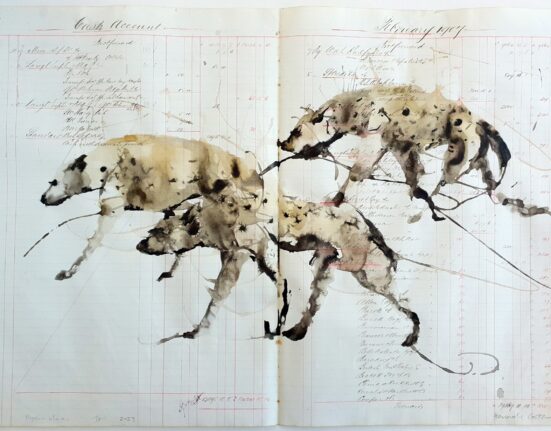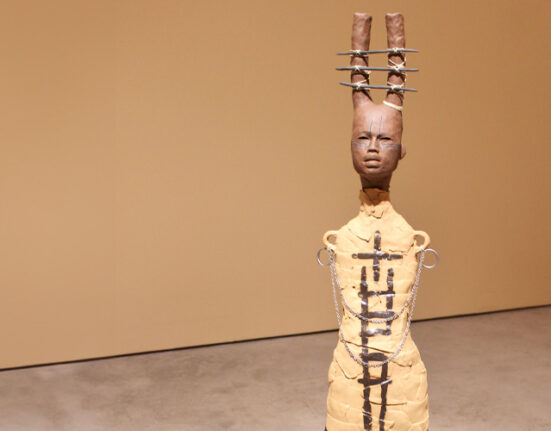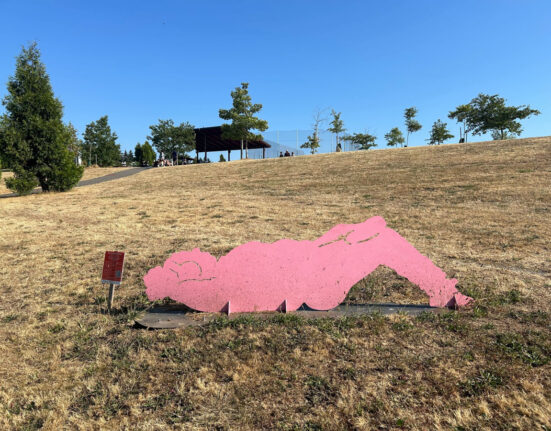
“There is no such thing as bad publicity,” circus owner Phineas T. Barnum supposedly said, and perhaps that is true. “When Piss Christ became a national issue 36 years ago, I was an unknown artist,” said photographer Andres Serrano, referring to his 1987 photograph of a crucifix submerged into a glass filled with urine, adding that “the controversy jump-started my career.” The photograph, created while Serrano was a recipient of a $15,000 grant from the Southeastern Center for Contemporary Art in Winston-Salem, North Carolina, which itself had received a grant from the National Endowment for the Arts in fiscal year 1987-88, drew fiery condemnation from religious groups around the United States, as well as from members of Congress, including North Carolina Senator Jesse Helms. Coming at the same time as the controversy over the indirectly government-sponsored exhibition of the work of photographer Robert Mapplethorpe, the outcry came close to abolishing the federal arts agency. The NEA survived, although in a somewhat weaker form, but Serrano flourished. “Collectors rushed to support me. I’ve sold a lot of work, and I wouldn’t have sold anywhere near that much if the controversy hadn’t occurred.”
The history of art is filled with works that, intentionally or otherwise, shocked the bourgeoisie and led to little-known artists becoming better known (Edouard Manet’s Olympia comes to mind) and to artists well-known in the art world becoming what you might call ‘pop cultural famous’ (as with Richard Serra’s Tilted Arc). Controversy and instances of censorship might seem to be good career moves.


That has probably been the case for photographer Sally Mann, whose images of her unclothed children were seized by local police and taken down from a group exhibition titled “Diaries of Home” at the Modern Art Museum of Fort Worth in Texas this past January. A local elected official, Tarrant County Judge Tim O’Hare, told the Dallas Express that Mann’s photographs are “grossly inappropriate at best,” adding that “they should be taken down immediately and investigated by law enforcement for any and all potential criminal violations.” A spokesperson for the Fort Worth Police Department declined to identify who reported the four images or when the complaint against them was lodged, but in late March, a grand jury in Tarrant County, Texas, declined to indict Mann on the charges of child pornography, effectively ending the case.
Controversy isn’t new for Mann, whose work has been exhibited in major museums across the country and periodically denounced by religious groups. Whether or not increased sales, prices and opportunities to show her photographs resulted is unclear. Certainly, great public controversies or instances of censorship can’t help but affect an artist in some significant way. For certain artists, there is a clear upside. “I like to think that my career would have reached this level without the help of the FBI,” said photographer Jock Sturges, whose San Francisco studio was raided in 1990 by the Bureau, which confiscated and destroyed many of the artist’s prints and negatives of nude children before a federal grand jury failed to indict Sturges. “Certainly, the feds pushed my career ahead by 10 years.”
David Hammons gained considerable publicity and new collectors in 1989 when his sculpture of a blond and blue-eyed version of Jesse Jackson, How Ya Like Me Now?, was attacked with sledgehammers by a group of Black men who felt the work disparaged Jackson while being shown outdoors in Washington, D.C. The artist repaired the piece in time for a retrospective, adding to the work sledgehammers and the logo of the cigarette maker Lucky Strike since “it was lucky for me that those men struck the piece with sledgehammers because that got everyone to notice me.”
Conservative outrage in the late 1980s and early 1990s over the homoerotic images of Robert Mapplethorpe elevated his professional stature “from a photographer known to some people to an artist in the canon” of great 20th-century talents, according to Michael Ward Stout, president of the Robert Mapplethorpe Foundation, which was established by the artist a year before his death from AIDS in 1989. “He left a very big inventory of work, and there was a thriving market,” he told Observer. “At the time, I was worried that it was too much, too much publicity,” but the condemnations didn’t negatively affect Mapplethorpe personally—he was dead—or interest in his work.
SEE ALSO: Queer Art and the Immaterial Griefs of the AIDS Crisis
In the years since, Stout said, well over a hundred museums around the world have acquired the artist’s photographs for their permanent collections, including New York’s Museum of Modern Art, which in the past 10 years has purchased thirty-five works. “Since his death, Mapplethorpe is no longer considered a weird, sadistic pornographer but, instead, an important artist and a philanthropist whose foundation sponsors AIDS research.”
For other artists, though, the impact of controversy and censorship may be less than positive. Both may elevate an artist’s name and face long enough for the individual to become the focus of death threats and hate mail, snubs from collectors, dealers and curators with little but a tarnished reputation to show for it. Women, in particular, tend to have a rougher go of it than their male counterparts.
“Controversy hasn’t been a fast track to success for me,” said the late Kate Millett, whose 1970 The American Dream Goes to Pot featuring an American flag partially stuffed into a toilet behind prison bars has been picketed by veterans groups and others whenever it has been displayed. When the work was exhibited as part of an “Old Glory” show at the Phoenix Art Museum in 1996, it was met with protests and condemnations from Senator Jesse Helms, House of Representatives Speaker Newt Gingrich and then-presidential candidate Bob Dole. “I’ve gotten a sort of notoriety because of that piece and some others I’ve done but, in another way, the controversy hasn’t affected me a lot because I’ve never been able to sell my sculpture. All my life, collectors and curators have backed away from me. No dealer has come to me for any purpose whatsoever. I think I’ve sold only a couple of works to friends for $350 apiece.”
Controversy did work in her favor after her 1971 book Sexual Politics was published, which became an instant classic among feminists, but her artwork never benefited. Why exactly one artist’s career is aided by controversy while another’s is not is not something easily understood. Senator Helms’ denounced both Serrano and Millett, both of whom produced work that caused viewer discomfort; collectors, critics, curators and dealers rallied around Serrano but avoided Millett.


The studio of photographer Marilyn Zimmerman, a tenured professor at Wayne State University in Michigan, was raided in 1993 by police who confiscated prints and negatives in a manner similar to the raid on Sturges’ studio. She, like Sturges, took photographs of a nude child—her own daughter, in fact—and the district attorney decided to drop all charges in the face of protests. However, “there was no great surge of interest from collectors in buying my work or from dealers who might show my work,” she told Observer. But the fear that the raid created in her life “did stop me from photographing the nude. I use other appropriated images instead. Frankly, for a long while, I lost the heart to make images.” More devastating, she also lost her daughter when her ex-husband used the controversy to gain primary custody in court.
Holly Hughes, a queer performance artist and director of the BFA program in Interarts Performance at the University of Michigan, eventually landed on her feet but for a time in the late 1980s and early ‘90s feared for her livelihood when she was grouped with several other LGBTQ+ artists as part of the Culture Wars campaign to abolish the National Endowment for the Arts for its support of their work. “I’m not like Serrano and Sturges with objects to sell,” she told Observer. “I do performances, and a lot of performances I was scheduled to do at the time were canceled. There were signed contracts that just didn’t get honored. It was a real financial hit,” and the controversy “never translated into something positive professionally.”
But the largest hit was emotional: having been elevated to the heights of celebrity only to be denounced. “I was called a ‘garbage artist’ on the floors of Congress,” she said. “I received a schooling in what it means when government entities label you as an enemy.” Another artist, Dread Scott, whose 1989 work in an exhibition at the School of the Art Institute of Chicago, What is the Proper Way to Display the U.S. Flag? required viewers to walk on a flag in order to read from a book, received death threats in the mail, as did his mother. The notoriety, however, did not have a lasting effect on his art career, which has since prospered.
In the long term, the emotional toll of being attacked for one reason or another may be mitigated by better publicity and sales, but scars remain. Within the first five weeks of the FBI raid on his studio, Sturges said that he had spent $80,000 on legal fees, “lost 40 pounds, I couldn’t sleep; I was anxious all the time. If I had been convicted, the sentence would have been 10 years. I thought I was going to prison. I had read that child pornographers were usually raped and brutalized in jail, and I would get AIDS. I thought I was under a death sentence.” He sought psychiatric help.
For all the photographic images that Andres Serrano took before and since Piss Christ, he remains best known for that image and the criticism he received at the time— “words like ‘sacrilege’ and ‘blasphemy’ were thrown my way,” and they still smart. “I’m a Christian who grew up in a Christian family surrounded by Christian symbols. It was only natural for me to use the symbols of my faith in my work.” He noted that he had received an invitation to meet with Pope Francis, which wouldn’t have happened “if they thought I was anti-Christian.” Still, “my reputation as a controversial artist was sealed.” Did his prices go up after the controversy? He supposes so but never tracked the actual impact. “I always let my galleries do their business as I do mine.”







